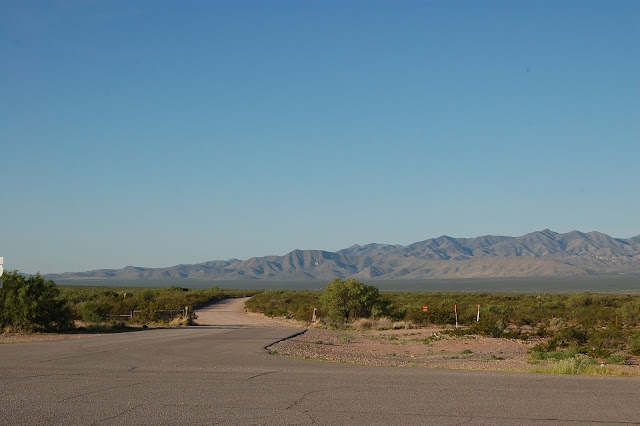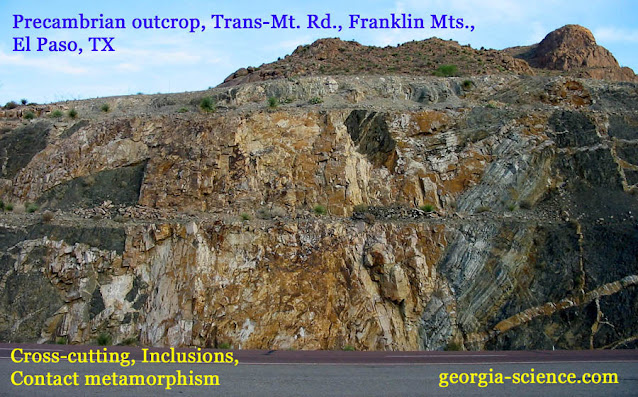
It's been forty years since I spent 10 weeks of the summer in the Eagle Mts. of Hudspeth County, Texas. [From a few miles away, at the I-10 Allamoore - Hot Wells exit, the Eagle Mountains don't seem so imposing, but once past the outer rampart of hills, it was quite the adventure in 1978.]
In the photo, the southern "half" of the east side of the mountains is shown, with Eagle Peak being the highest point near the right margin of the photo. The low hills (on the left) and the low ridge (on the right) that make up the eastern margin of the mountains consist of Cretaceous sedimentary rocks, probably remnants of the Laramide thrust sheet upon which the caldera was superimposed. The area was later modified by Basin and Range faulting as well. In the foreground is Eagle Flat, which occupies most of the area east of Sierra Blanca and west of the Carrizo Mountains.
The Eagle Mountains were the site of my originally-planned Master's Thesis. (Sometimes, when I get nostalgic/ melancholic, I go back to the Eagle Mountains in my mind, as I did
here.) Because of intervening "life events", I never got that project finished, but later did a Thesis west of El Paso, associated with the Quaternary
Aden Crater basalts.
I was part of a group of four UTEP Geology grad students working on the Oligocene caldera that forms the core of the Eagle Mountains. Due to its size, the volcanic core was divided into quadrants. As the topographic maps suggested that the southern "half" of the mountains was more rugged than the northern "half" and I had the only 4x4 vehicle (below), it was decided that I would do the SE quadrant and my field partner Dan would do the SW quadrant.

During my 10 weeks in the Eagle Mountains, my truck camper was my home. No A/C, no "indoor plumbing" (further details not needed), but with power steering, a manual transmission, and 4-wheel-drive, in its youth, my 1976 Jeep J-10 was a pretty good field vehicle for off-pavement use. After this 1977 photo, my Dad and I added a sliding rear window to the truck cab and an inflatable "boot" to seal the gap between the cab and camper to allow inclement-weather passage.
Usually, Dan and I would head into Van Horn for supplies every 4th day or so, as supplies of ice, food, and gasoline would only last that long. The roads were rugged enough that I was almost constantly grinding around the roads in 1st gear and 4-wheel-drive, reducing the truck's bad gas mileage (12 mpg) even more.
In the northern "half" of the mountains, Mike was doing the NE quadrant and Bob was doing the NW quadrant. The first day or so that we were in the mountains, Dan and I hung out in the northern "half" of the mountains with Mike and Bob, just to get acquainted with the terrain and the existing geologic map we were using as a reference.
Once we had checked in at the Eagle Mountains ranch house, we followed the winding roads northward between the hills within the NE quadrant. As we drove over the hills and were out of sight of the ranch house, perhaps without realizing it, we were being introduced to the concepts of "Orographic Lifting" and "Micro-Climates", without realizing it. Within nearby Eagle Flat, that we crossed on our way to the mountains, the dominant plant was
Creosote Bush (
Larrea tridentata) along with other typical Chihuahuan Desert plants. In contrast, the area in which we were driving was an actual grassland with pine trees (the limb of one pine tree removed my right side mirror and radio antenna)
[To be continued: in Part 2]
References:
Underwood, James R., 1980 Geology of the Eagle Mts., Hudspeth County, Texas.










